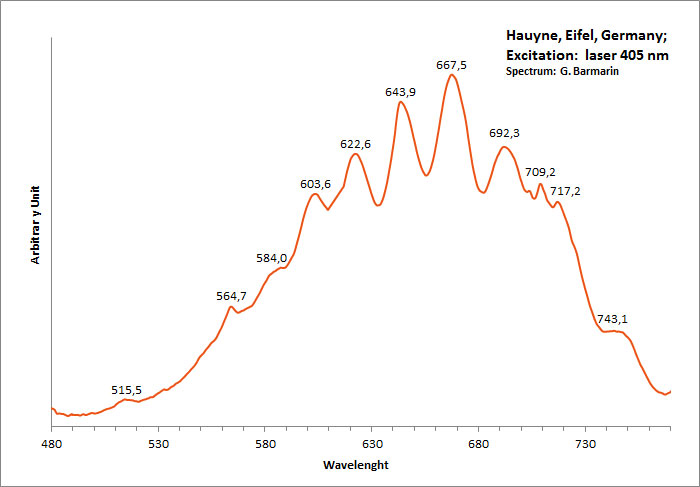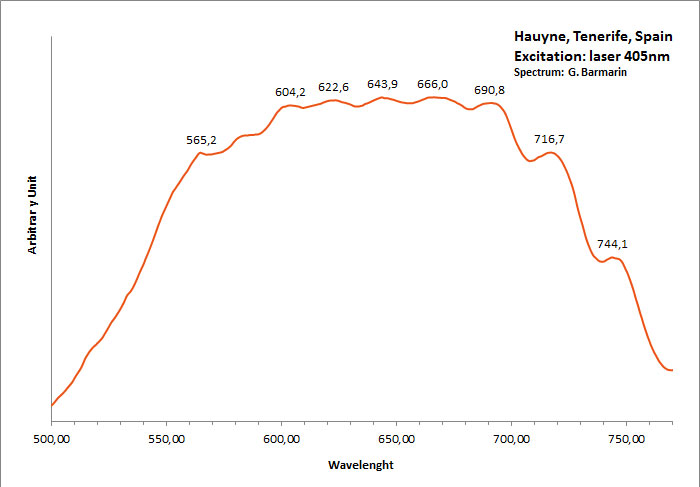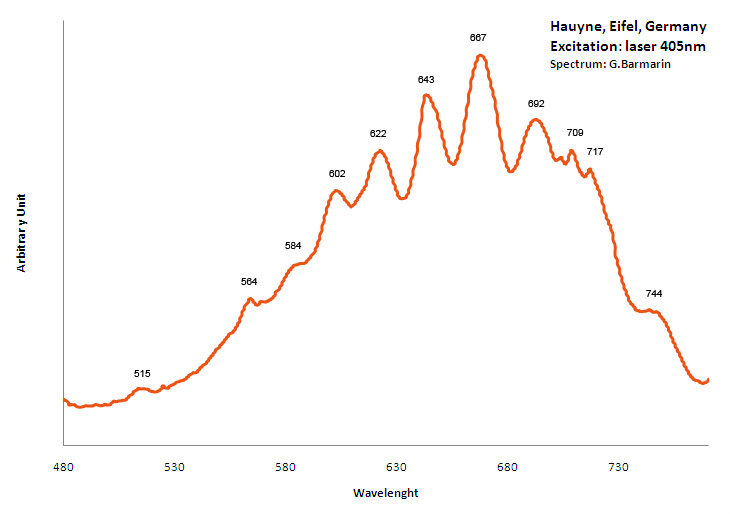Database of luminescent minerals
HAUYNE
Chemical formula: (Na,Ca)4-8Al6Si6(O,S)24(SO4,Cl)1-2
Family: Silicates
Status: IMA-GP
Crystal system : Isometric
Display mineral: NON
Associated names (luminescent varieties, discredited names, synonyms, etc.): Lapis-lazuli,
Luminescence:
Longwave UV (365nm) colors: |
Orange Red , Orange , Red , Pink , Salmon pink , | ||
Intensity LW:Medium | |||
Midwave UV (320nm) colors: |
Pink , | ||
Intensity MW:Very weak | |||
Shortwave UV (254nm) colors: |
Red , | ||
Intensity SW:Weak | |||
Daylight picture

HAUYNE, Laach lake volcanic complex, Eifel Mts,
Rhineland-Palatinate, Germany ;
Col. G.Barmarin; Photo: G. Barmarin
Longwave (365nm) picture

HAUYNE, Laach lake volcanic complex, Eifel Mts,
Rhineland-Palatinate, Germany ; UVLW
Col. G.Barmarin; Photo: G. Barmarin
Shortwave (254nm) picture

HAUYNE, Laach lake volcanic complex, Eifel Mts,
Rhineland-Palatinate, Germany ; UVSW
Col. G.Barmarin; Photo: G. Barmarin
Do you have a photo of this mineral you would like to see in the gallery? Contact us!
Phosphorescence (in the common sense of the term) observable with the naked eye:
No data
Comments:
Fluorescence of Hauyne of Laacher See, Eifel, Germany, has been described by Gunnell in 1939 (probably in The Mineralogist). As the sulfide replaces the sulfate in Hauyne it loses its fluorescence and becomes opaque and is the classic Lazurite. To be real Lazurite, it must be sulfide dominant and none have ever been found, so all lazurite is hauyne! (http://www.mindat.org/photo-586625.html) In practice: darker samples are considered as the variety Lazurite.
Activator(s) and spectrum:
Activator(s): S2-,
Peaks in the spectrum (nm):
S2- repl.[SO4]2- : band centered around 680 nm with ondulations at: 516, 563, 580, 604, 621, 644, 666, 691, 715, 745nm

Hauyne, Tenerife, Spain.
Excitation: laser 405nm. Col. G. Barmarin; Spectre: G. Barmarin
Spectrum Galery:


 ...
...Comments on spectrum and activators:
Form of the spectrum: typical wavelet of S2- upon a large band.
Best localities for fluorescence (*):
- In den Dellen quarries, Niedermendig, Mendig, Laach lake (Laacher See) volcanic complex, Eifel Mts, Rhineland-Palatinate, Germany;
- Punta Camello, Arucas, Gran Canaria, Las Palmas Province, Canary Islands, Spain;
- Monte Somma, Somma-Vesuvius Complex, Naples Province, Campania, Italy;
- Ladjuar Medam, Sar-e Sang, Koksha Valley, Khash & Kuran Wa Munjan Districts, Badakhshan Province, Afghanistan;
- Sacrofano, Sacrofano Caldera, Rome Province, Latium, Italy (light pink LW);
- Fosso Attici, Magliano Romano, Latium, Italy;
(*)The data are not exhaustive and are limited to a few remarkable localities for fluorescence
Bibliographic reference for luminescence:
- The Henkel Glossary of Fluorescent Minerals, Dr. Gerhard Henkel, Published by the FMS, 1989 ,
- Fluorescence: Gems and Minerals Under Ultraviolet Light, Manuel Robbins, 1994, Geoscience Press, ISBN 0-945005-13-X ,
- Luminescence Spectroscopy of Minerals and Materials, M. Gaft, R. Reisfeld, G. Panczer, Springer Editor, ISBN: 10 3-540-21918-8 ,
- Luminescent Spectra of Minerals, Boris S. Gorobets and Alexandre A. Rogojine, Moscow, 2002 ,
- Handbook of Fluorescent Gems and Minerals, a practical guide for the gem and mineral collector, Jack de Ment, 1949 ,
Reference for luminescence on the Internet:
- Haüyne from the Eifel District, Germany, Gems and Gemmology, Volume 36, Number 3 / Fall 2000
- GemologyOnline.com
Images:
- Canary Islands, Spain: http://www.mindat.org/photo-609329.html
- Afghanistan: http://www.mindat.org/photo-586626.html
- Laacher See, Germany: https://www.mindat.org/photo-900689.html
- Lazio (Latium), Italy: https://www.mindat.org/photo-1220673.html
Mineralogical reference on the Internet:
 http://www.mindat.org/show.php?name=Hauyne
http://www.mindat.org/show.php?name=Hauyne
 http://webmineral.com/data/Hauyne.shtml
http://webmineral.com/data/Hauyne.shtml
Internet Search:
 Image search on 'Google Images'
Image search on 'Google Images'
 Search for documents in all languages on Google
Search for documents in all languages on Google
A request providing no result means only that no such reference exists in the database, but it does not mean that what you are looking for does not exist, just not to our knowledge. If you think you have found an error or omission, please let us know via the contact page being sure to cite the source of information.

